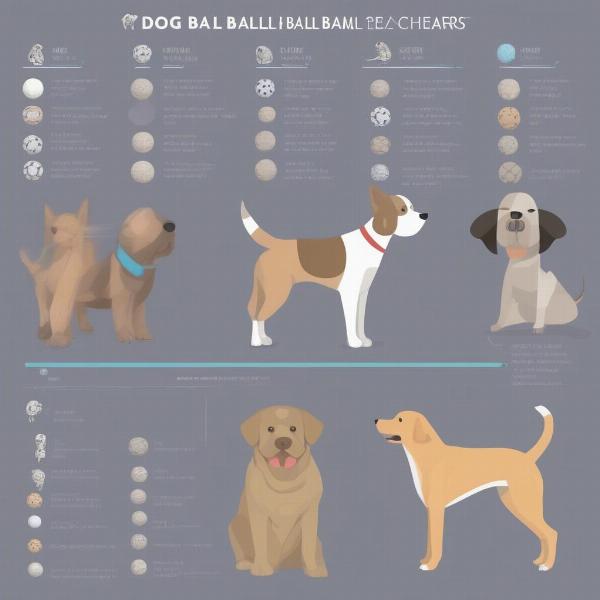Dog balls are more than just simple toys; they’re a gateway to fun, exercise, and bonding with your furry friend. Whether you’re a new dog owner or a seasoned pro, choosing the right dog ball can make all the difference in your dog’s playtime enjoyment and overall well-being. This guide will explore everything you need to know about dog balls, from selecting the right size and material to understanding the different types available and ensuring safe play.
Choosing the perfect dog ball involves considering your dog’s breed, size, age, and chewing habits. A small ball could be a choking hazard for a large dog, while a large ball might be too cumbersome for a smaller pup. The material also plays a crucial role. Some dogs are aggressive chewers, requiring durable rubber balls, while others prefer softer, plush toys.
Types of Dog Balls
The world of dog balls extends beyond the classic rubber sphere. From textured surfaces for added stimulation to balls with squeakers for extra excitement, the options are vast and varied.
- Standard Rubber Balls: These are the classic go-to for fetch and playtime. They’re durable, easy to clean, and come in various sizes.
- Treat-Dispensing Balls: These interactive balls keep dogs engaged by dispensing treats as they play. They’re a great way to combine mental and physical stimulation.
- Rope Balls: Combining a ball with a rope adds an extra element of fun for tug-of-war and chewing.
- Tennis Balls: A popular choice, but be mindful of the abrasive felt, which can wear down a dog’s teeth over time.
- Glow-in-the-Dark Balls: Perfect for evening playtime, these balls offer visibility and added fun in low-light conditions.
Choosing the Right Size and Material
Selecting the appropriate size is crucial for safety. A ball that’s too small can be swallowed, leading to choking or intestinal blockage. Conversely, a ball that’s too large can be difficult for your dog to pick up and carry. Consider your dog’s size and jaw strength when making your choice.
The material is just as important. For aggressive chewers, look for durable, non-toxic rubber. Softer materials like plush or fabric are suitable for gentle chewers. Always inspect the ball regularly for signs of wear and tear, replacing it when necessary.
 Dog Ball Size Chart based on Breed
Dog Ball Size Chart based on Breed
Ensuring Safe Play with Dog Balls
While dog balls offer endless entertainment, safety should always be a priority. Supervise your dog during playtime, especially with new balls. Avoid balls with small parts that could be chewed off and swallowed. Choose balls specifically designed for dogs, as other types may contain harmful materials.
Dr. Emily Carter, a veterinary behaviorist at the Animal Behavior Clinic of New York, advises, “Always supervise your dog’s playtime with balls, especially if they are prone to chewing. Check the ball regularly for damage and replace it when necessary to avoid potential hazards.”
Dog Ball Games and Activities
Beyond fetch, there are numerous games you can play with your dog and a ball. Hide-and-seek with the ball, rolling it down a hill, or even teaching your dog to “dunk” the ball in a bucket can provide hours of fun and exercise.
Conclusion
Dog balls are a simple yet powerful tool for enriching your dog’s life. By carefully considering size, material, and safety, you can ensure your furry friend enjoys countless hours of fun, exercise, and bonding with their favorite toy. Remember to always supervise playtime and choose dog balls from reputable sources.
FAQ
- What is the best type of dog ball for aggressive chewers? Durable rubber balls made from non-toxic materials are best for aggressive chewers.
- Can tennis balls be harmful to dogs? The abrasive felt on tennis balls can wear down a dog’s teeth over time. Consider them for occasional play, not everyday use.
- What size dog ball is right for my puppy? Choose a ball size that is appropriate for your puppy’s age and breed, ensuring it’s not small enough to be swallowed.
- How can I make dog ball play more engaging? Try incorporating interactive games like hide-and-seek, or use a dog ball fetcher for longer throws.
- What should I do if my dog swallows a piece of a dog ball? Contact your veterinarian immediately.
- Are there dog balls that can help clean my dog’s teeth? Yes, some dog balls have textured surfaces designed to help clean teeth as the dog chews. Consider a toothy dog ball for this purpose.
- Can I use a dog ball gun for fetch? Absolutely! A dog ball gun can make fetch more exciting and allows for longer throws.
Related Articles:
About ILM Dog: ILM Dog provides expert advice and resources for dog owners worldwide. From breed selection and health care to training and nutrition, we offer comprehensive information to help you provide the best possible care for your canine companion. Our services cover a wide range of topics including dog breeds, health, training, nutrition, grooming, and products & accessories. We strive to empower dog owners with the knowledge they need to make informed decisions about their dog’s well-being. Contact us today for expert advice: Email: [email protected], Phone: +44 20-3965-8624.